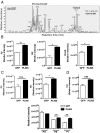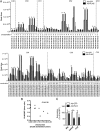Liver Perilipin 5 Expression Worsens Hepatosteatosis But Not Insulin Resistance in High Fat-Fed Mice
- PMID: 26296152
- PMCID: PMC4588733
- DOI: 10.1210/me.2015-1069
Liver Perilipin 5 Expression Worsens Hepatosteatosis But Not Insulin Resistance in High Fat-Fed Mice
Abstract
Perilipin 5 (PLIN5) is a lipid droplet (LD) protein highly expressed in oxidative tissues, including the fasted liver. However, its expression also increases in nonalcoholic fatty liver. To determine whether PLIN5 regulates metabolic phenotypes of hepatosteatosis under nutritional excess, liver targeted overexpression of PLIN5 was achieved using adenoviral vector (Ad-PLIN5) in male C57BL/6J mice fed high-fat diet. Mice treated with adenovirus expressing green fluorescent protein (GFP) (Ad-GFP) served as control. Ad-PLIN5 livers increased LD in the liver section, and liquid chromatography with tandem mass spectrometry revealed increases in lipid classes associated with LD, including triacylglycerol, cholesterol ester, and phospholipid classes, compared with Ad-GFP liver. Lipids commonly associated with hepatic lipotoxicity, diacylglycerol, and ceramides, were also increased in Ad-PLIN5 liver. The expression of genes in lipid metabolism regulated by peroxisome proliferator-activated receptor-α was reduced suggestive of slower mobilization of stored lipids in Ad-PLIN5 mice. However, the increase of hepatosteatosis by PLIN5 overexpression did not worsen glucose homeostasis. Rather, serum insulin levels were decreased, indicating better insulin sensitivity in Ad-PLIN5 mice. Moreover, genes associated with liver injury were unaltered in Ad-PLIN5 steatotic liver compared with Ad-GFP control. Phosphorylation of protein kinase B was increased in Ad-PLIN5-transduced AML12 hepatocyte despite of the promotion of fatty acid incorporation to triacylglycerol as well. Collectively, our data indicates that the increase in liver PLIN5 during hepatosteatosis drives further lipid accumulation but does not adversely affect hepatic health or insulin sensitivity.
Figures





References
-
- Loomba R, Sanyal AJ. The global NAFLD epidemic. Nat Rev Gastroenterol Hepatol. 2013;10:686–690. - PubMed
-
- Argo CK, Caldwell SH. Epidemiology and natural history of non-alcoholic steatohepatitis. Clin Liver Dis. 2009;13:511–531. - PubMed
-
- Starley BQ, Calcagno CJ, Harrison SA. Nonalcoholic fatty liver disease and hepatocellular carcinoma: a weighty connection. Hepatology. 2010;51:1820–1832. - PubMed
-
- Neuschwander-Tetri BA. Hepatic lipotoxicity and the pathogenesis of nonalcoholic steatohepatitis: the central role of nontriglyceride fatty acid metabolites. Hepatology. 2010;52:774–788. - PubMed
Publication types
MeSH terms
Substances
Grants and funding
LinkOut - more resources
Full Text Sources
Other Literature Sources
Research Materials

